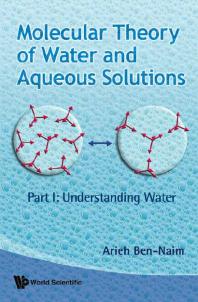书目详情:
CONTENTSPrefacePostcriptAcknowledgmentsList of Abbreviations1. Survey of the Properties of Water Personal IntroductionPersonal Introduction1.1. Introduction and Some Historical Notes1.2. Properties of Water in the Gaseous Phase1.2.1. The single water molecule1.2.2. Interaction between two water molecules1.3. Properties of Water in the Solid Phase1.3.1. Ordinary ice1.3.2. The residual entropy of ice1.3.3. The phase diagram of water1.4. Properties of Water in the Liquid Phase1.4.1. Some outstanding properties of water1.4.2. Molar volume of water and its temperature dependence1.4.3. Heat capacity1.4.4. Isothermal compressibility1.4.5. The radial distribution function of water1.5. The Kirkwood–Buff Integral1.5.1. Ideal gas1.5.2. Inert gases represented as Lennard– Jones particles1.5.3. Water, methanol, and ethanol1.6. Solvation of Water in Water1.7. The Importance of Water in Biological Systems2. Theoretical Approaches to the Study of Liquid Water Personal IntroductionPersonal Introduction2.1. Introduction2.2. The General Theoretical Framework2.3. The Mixture-Model Approach to Liquid Water2.3.1. The origin of the mixture-model theory of water2.3.2. Wada’s two-structure model for water: The success and the limitation of the MM approach2.3.3. An exact MM approach to the theory of liquids2.3.3.1. The singlet generalized molecular distribution function2.3.3.2. Coordination number2.3.3.3. Volume of the Voronoi polyhedron2.3.3.4. Binding energy2.3.3.5. Combination of properties2.3.3.6. Some numerical examples2.3.3.7. The mixture-model approach to liquids2.3.4. Application of an exact two-structure model2.4. Lattice Models for Water2.4.1. Introduction2.4.2. The Pauling model and its solution2.4.3. The heat capacity and the isothermal compressibility2.5. A One-Dimensional Model for Water2.5.1. Introduction2.5.2. The primitive model and the corresponding partition function2.5.3. Selected illustrative results for the primitive model2.5.4. The primitive cluster model for water and its partition function2.5.5. Cluster’s size distribution2.5.6. Selected results for the primitive cluster model2.5.7. Some concluding remarks regarding the 1-D model for water2.6. A Two-Dimensional Model for Water2.6.1. Introduction2.6.2. The physical model of water-like particles in two dimensions2.6.3. The application of the Percus–Yevick equation to the BN2D model2.6.4. Simulated results2.6.5. Further development of the 2-D model2.7. Three-Dimensional Models for Water2.7.1. Introduction: A new era of water research2.7.2. Effective pair potential for water2.7.3. Second virial coefficients of water2.7.4. Definition of the structure of water2.7.5. An approximate method of calculating the structure of water2.7.6. Solvation of water in pure water2.7.7. Distribution of species of water molecules2.7.8. Application of the Percus–Yevick equation2.7.9. Application of cluster expansion to water2.7.10. Simulated results3. Water with One Simple Solute Personal IntroductionPersonal Introduction3.1. Introduction and Some Historical Notes3.2. Survey of Some Properties of Simple Aqueous Solutions3.3. Solvation and Conditional Solvation3.3.1. Definition of the solvation process3.3.2. Hydrophobic and hydrophilic solutes3.3.3. Why do we need solvation quantities?3.4. Statistical Mechanical Expressions for the Solvation Thermodynamic Quantities3.5. Application of the Mixture-Model Approach to Water3.5.1. Application of a two-structure model TSM)3.5.2. Generalization to any mixture model of water3.6. Application of an Interstitial Model for Water to Aqueous Solutions3.7. The Problem of Stabilization of the Structure of Water3.7.1. The concept of structural temperature3.7.2. Formulation of the problem within the mixture-model approach3.7.3. The application of the Kirkwood–Buff theory3.7.4. An exact argument for a hardpoint solute3.7.5. An approximate measure of the structural change induced by the solute3.7.6. An empirical estimate of the structural changes induced by the solute on the solvation entropy3.8. Application of the Scaled Particle Theory3.9. Application of a One-Dimensional Model3.9.1. Introduction3.9.2. Solvation of hard rods in the primitive model for water3.9.3. Application of the primitive cluster model for dilute solutions of inert solutes3.9.4. Results for HR solute in dilute solutions of the primitive cluster model3.10. Applications of Two-Dimensional Models3.11. Applications of Three-Dimensional Models4. Water with Two Solute Molecules; Hydrophobic Hydrophilic Phenomena Personal IntroductionPersonal Introduction4.1. Introduction4.2. The Experimental Evidence4.3. Redefinition of the H O Interaction4.4. A Simple Measure of the Strength of the “Pure” HφO Interaction4.4.1. Some experimental data on the strength of HφO interactions4.4.2. HφO interaction among m identical spherical non-polar solute particles4.4.3. Attaching a methyl group to various hydrocarbons4.4.4. Attaching an ethyl group to various molecules4.4.5. The hydrophobic interaction at zero separation4.4.6. The hydrophobic interaction at contact distance between the two solutes4.4.7. An improved approximate measure of the HφO interaction4.5. Intramolecular HφO Interactions4.5.1. A simple measure of the intramolecular HφO interaction4.5.2. Mixed HφO.HφI interactions4.6. Application of the Scaled Particle Theory4.7. Temperature and Pressure Dependence4.7.1. Some experimental values of the entropy, enthalpy, and volume changes associated with the HφO interaction4.7.2. Formal statistical mechanical expressions for δG, δS, δH, and δV for the HφO process4.7.3. Hydrophobic interaction and structural changes in the solvent4.7.4. A measure of the amount of structural changes in the solvent4.8. Solvent Induced Interactions Between Two Hydrophilic HφI Groups4.8.1. The HφI interaction at R1 . 2.76A4.8.2. The HφI interaction at R2 = 4.5A4.8.3. Intramolecular HφI interactions4.9. Application of One-Dimensional Models to Study Hydrophobic Interactions4.10. Application of Two-Dimensional Models4.11. Application of Three-Dimensional Models4.12. Hydrophobic or Hydrophilic? That is the Question!4.12.1. A short history of the rise and fall of hydrophobia and hydrophilia4.12.2. The decline of the hydrophilic effect4.12.3. The rise of the HφO effect4.12.4. The resurgence of the HφI effectsAppendicesAppendix A: The Tetrahedral GeometryAppendix B: Calculation of the Residual Entropy of WaterAppendix C: The Kirkwood–Buff Integrals for an Ideal GasAppendix D: The Equivalence Between the One-Component and the Mixture-Model Views of the Same SystemAppendix E: The Generalized Euler TheoremAppendix F: Some Identities in the Mixture-Model ApproachAppendix G: The Statistical Mechanical Expression for the Solvation Gibbs Energy of Hard Spheres and the Work of Cavity FormationAppendix H: The Solubility of a Simple Solute in Water and Structural Changes Induced in the SolventAppendix I: An Estimate of the Strength of Hydrophilic Interaction at R = 4.5ÅAppendix J: Calculated Data on HφI InteractionsAppendix K: Experimental Evidence for the Entropy-Enthalpy CompensationAppendix L: Solutions to Selected ExercisesReferencesIndex
评论:








